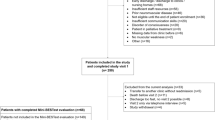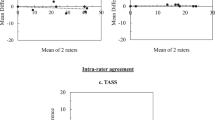Abstract
Study design
Single institution observational study.
Objectives
To investigate the ceiling and floor effects of the Berg Balance Scale (BBS), Mini-Balance Evaluation Systems Test (BESTest), and Brief-BESTest, as well as to determine the intra- and inter-rater reliabilities and minimal detectable change (MDC) of the Mini-BESTest and Brief-BESTest in patients with acute and subacute incomplete cervical spinal cord injury (SCI) classified as AIS D.
Setting
Advanced critical care center of our university hospital.
Methods
Twenty patients with incomplete cervical SCI who could stand without assistance were recruited. The floor and ceiling effects were evaluated by plotting histograms from the distribution of scores on the BBS, Mini-BESTest and Brief-BESTest, and calculating skewness. The Mini-BESTest and Brief-BESTest were evaluated and videotaped simultaneously, and intra- and inter-rater reliabilities were assessed. The MDC was also calculated.
Results
The skewness of the BBS was −1.57, and the full score was 35%, indicating a ceiling effect. However, no ceiling or floor effect was observed for the Mini-BESTest and the Brief-BESTest. Intraclass correlation coefficients for intra-rater and inter-rater reliabilities were 0.98 and 0.97 for the Mini-BESTest and Brief-BESTest, respectively. Individual item reliability was moderate or better for the Mini-BESTest and excellent or better for the Brief-BESTest. The MDC of total scores ranged 3.14–3.84 and 2.92–3.60 for the Mini-BESTest and Brief-BESTest, respectively.
Conclusions
The Mini-BESTest and Brief-BESTest are reliable assessment tools for patients with acute and subacute incomplete SCI classified as AIS D. Clarified error ranges aid in estimating the treatment effect on balance abilities.
This is a preview of subscription content, access via your institution
Access options
Subscribe to this journal
Receive 12 print issues and online access
$259.00 per year
only $21.58 per issue
Buy this article
- Purchase on SpringerLink
- Instant access to full article PDF
Prices may be subject to local taxes which are calculated during checkout


Similar content being viewed by others
Data availability
Mini-BESTest, Brief-BESTest, and BBS data generated and analyzed during this study are included in this published article (see Supplementary Table 3). Due to privacy concerns, demographic and clinical data are not publicly accessible but are available from the corresponding author upon reasonable request.
References
Miyakoshi N, Suda K, Kudo D, Sakai H, Nakagawa Y, Mikami Y, et al. A nationwide survey on the incidence and characteristics of traumatic spinal cord injury in Japan in 2018. Spinal Cord. 2021;59:626–34.
Lemay JF, Noamani A, Unger J, Houston DJ, Rouhani H, Musselmann KE. Using wearable sensors to characterize gait after spinal cord injury: evaluation of test-retest reliability and construct validity. Spinal Cord. 2021;59:675–83.
Arora T, Oates A, Lynd K, Musselman KE. Current state of balance assessment during transferring, sitting, standing and walking activities for the spinal cord injured population: A systematic review. J Spinal Cord Med. 2020;43:10–23.
Berg K. Measuring balance in the elderly: preliminary development of an instrument. Physiother Can. 1989;41:304–11.
Lemay JF, Nadeau S. Standing balance assessment in ASIA D paraplegic and tetraplegic participants: concurrent validity of the Berg Balance Scale. Spinal Cord. 2010;48:245–50.
Jørgensen V, Opheim A, Halvarsson A, Franzén E, Roaldsen KS. Comparison of the Berg balance scale and the Mini-BESTest for assessing balance in ambulatory people with spinal cord injury: Validation study. Phys Ther. 2017;97:677–87.
Sibley KM, Beauchamp MK, van Ooteghem K, Straus SE, Jaglal SB. Using the systems framework for postural control to analyze the components of balance evaluated in standardized balance measures: a scoping review. Arch Phys Med Rehabil. 2015;96:122–132.e129.
Horak FB, Wrisley DM, Frank J. The Balance Evaluation Systems Test (BESTest) to differentiate balance deficits. Phys Ther. 2009;89:484–98.
Franchignoni F, Horak F, Godi M, Nardone A, Giordano A. Using psychometric techniques to improve the balance evaluation systems test: the mini-BESTest. J Rehabil Med. 2010;42:323–31.
Viveiro LAP, Gomes G, Bacha J, Junior N, Kallas M, Reis M, et al. Reliability, validity, and ability to identity fall status of the Berg balance scale, Balance Evaluation Systems Test (BESTest), Mini-BESTest, and Brief-BESTest in older adults who live in nursing homes. J Geriatr Phys Ther. 2019;42:E45–54.
Padgett PK, Jacobs JV, Kasser SL. Is the BESTest at its best? A suggested brief version based on interrater reliability, validity, internal consistency, and theoretical construct. Phys Ther. 2012;92:1197–207.
Roy A, Higgins J, Nadeau S. Reliability and minimal detectable change of the mini-BESTest in adults with spinal cord injury in a rehabilitation setting. Physiother Theory Pract. 2021;37:126–34.
Winairuk T, Pang MYC, Saengsirisuwan V, Horak FB, Boonsinsukh R. Comparison of measurement properties of three shortened versions of the balance evaluation system test (BESTest) in people with subacute stroke. J Rehabil Med. 2019;51:683–91.
Huang M, Pang MY. Psychometric properties of Brief-Balance Evaluation Systems Test (Brief-BESTest) in evaluating balance performance in individuals with chronic stroke. Brain Behav. 2017;7:e00649. https://doi.org/10.1002/brb3.649
Chiu AYY, Pang MYC. Assessment of psychometric properties of various balance assessment tools in persons with cervical spondylotic myelopathy. J Orthop Sports Phys Ther. 2017;47:673–82.
Jácome C, Cruz J, Oliveira A, Marques A. Validity, reliability, and ability to identify fall status of the Berg balance scale, BESTest, Mini-BESTest, and Brief-BESTest in patients with COPD. Phys Ther. 2016;96:1807–15.
Chan AC, Pang MY. Assessing balance function in patients with total knee arthroplasty. Phys Ther. 2015;95:1397–407.
Haakonsen SSD, Jørgensen L. Intra- and inter-rater reliability of the Mini-Balance Evaluation Systems Test in individuals with stroke. Int J Phys Med Rehabilitat. 2014; 02. https://doi.org/10.4172/2329-9096.1000177
Graves LY, Keane KF, Taylor JY, Wang TF, Saligan L, Bogie KM. Subacute and chronic spinal cord injury: a scoping review of epigenetics and secondary health conditions. Epigenet Insights. 2023;16:1–10.
Otaka E, OtakaY, Morita M, Yokoyama A, Kondo T, Liu M. Validation of the Japanese version of the Mini-Balance Evaluation Systems Test (Mini-BESTest). Jpn J Rehabil Med. 2014;51:673–81.
Otaka E, OtakaY, Morita M, Yokoyama A, Kondo T, Liu M. Validation of the Japanese version of the Balance Evaluation Systems Test (BESTest). Jpn J Rehabil Med. 2014;51:565–73.
Horak FB. The Balance Evaluation Systems Test training. 2024. http://www.bestest.us/training/ Accessed 23 March
Doane DP, Seward LE. Measuring skewness: A forgotten statistic? J Stat Educ. 2011;19:1–18.
Landis JR, Koch GG. The measurement of observer agreement for categorical data. Biometrics. 1997;33:159–74.
Bland JM, Altman DG. Statistical methods for assessing agreement between two methods of clinical measurement. Lancet. 1986;1:307–10.
Portney LG. Foundations of clinical research: applications to practice. 3rd ed. Upper Saddle River, NJ: Pearson/Prentice Hall, 2009.
McHugh ML. Interrater reliability: the kappa statistic. Biochem Med (Zagreb). 2012;22:276–82.
Gisev N, Bell JS, Chen TF. Interrater agreement and interrater reliability: key concepts, approaches, and applications. Res Social Adm Pharm. 2013;9:330–8.
Bravini E, Nardone A, Godi M, Guglielmetti S, Franchignoni F, Giordano A. Does the Brief-BESTest meet classical test theory and rasch analysis requirements for balance assessment in people with neurological disorders? Phys Ther. 2016;96:1610–9.
Tsang CSL, Liao LR, Chung RCK, Pang MYC. Psychometric properties of the Mini- Balance Evaluation Systems Test (Mini-BESTest) in community- dwelling individuals with chronic stroke. Phys Ther. 2013;93:1102–15.
Acknowledgements
We would like to thank Yuki Ishikawa, Yasuhiro Saito, and Koya Katsumi of the Saitama Medical Center for their cooperation in the recruitment process, especially the participants in the study.
Funding
This study was supported by the SMU-FHMC Grant 17-008.
Author information
Authors and Affiliations
Contributions
All authors conceptualized and designed the study, interpreted the data, read and critically revised the draft, and approved the final manuscript. YM collected and analyzed the data, wrote the manuscript, and obtained funding. YK wrote the manuscript. YO and SA recruited participants and served as evaluators. YT and SO managed this project.
Corresponding author
Ethics declarations
Competing interests
The authors declare no competing interests.
Ethical approval
This study was conducted after obtaining approval (S22-079) from the Research Ethics Committee of the Saitama Medical University Hospital.
Additional information
Publisher’s note Springer Nature remains neutral with regard to jurisdictional claims in published maps and institutional affiliations.
Supplementary information
Rights and permissions
Springer Nature or its licensor (e.g. a society or other partner) holds exclusive rights to this article under a publishing agreement with the author(s) or other rightsholder(s); author self-archiving of the accepted manuscript version of this article is solely governed by the terms of such publishing agreement and applicable law.
About this article
Cite this article
Morooka, Y., Takakura, Y., Kunisawa, Y. et al. Reliability of the Mini-BESTest and Brief-BESTest for assessing patients with incomplete spinal cord injury. Spinal Cord 62, 676–682 (2024). https://doi.org/10.1038/s41393-024-01032-2
Received:
Revised:
Accepted:
Published:
Issue date:
DOI: https://doi.org/10.1038/s41393-024-01032-2



